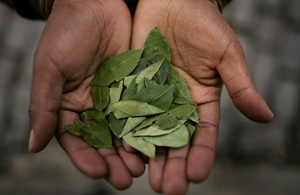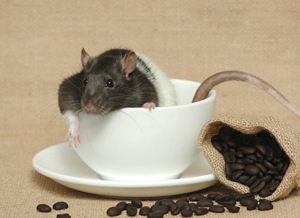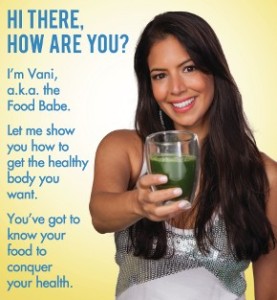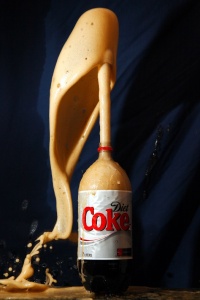By: Diana Maricruz Pérez Santos
The digital age has triggered one of the most disturbing problems in food science: good, bad and pathetic information available on the subject. Therefore, we must defend the vocation with the knowledge as the best weapon against such sensationalism.
Below are my opinions on five of the most fabulous food lies:
# 5. Cardboard Food: Cheetos are made from petroleum or cardboard, hence its stiff texture and the reason why they are incredibly flammable (video).
The lack of knowledge about the behavior of starch is responsible for this lie. When snacks like this are prepared, a mixture of flour and water are submitted to high temperatures and pressures in a process known as extrusion. Due to this environment, the polymeric structure of starch rearranges resulting in the characteristic texture of these snacks.
As for flammability, I think whoever started this whole thing has never burned their food before. Or heard how caloric value is determined.

coca leaves source: www.bucultureshocl.com
#4. Illegal ingredients: antifreeze in prepared salad dressings and cocaine in soft drinks are examples of this kind of rumor.
While laws vary in each country, each ingredient and food additive present in a food must be declared on the product label, and significant research must provide evidence that these additives do not harm the consumer.
So…antifreeze? Well, the compound in question here is propylene glycol. Yes it is an example of [non-toxic] antifreeze- it lowers the freezing point of aqueous solutions. That is simple chemistry. Salt does that, too. As a food ingredient, it is often used as a flavor carrier [1]. Importantly, the FDA classifies it as a GRAS (Generally Recognized As Safe) substance.
What about cocaine in soft drinks? Even though the original recipe of one major brand famously contained the coca plant-derived narcotic, modern recipes use other flavors or narcotic-free coca extracts. There are studies that demonstrate how the ingestion of a soft drink activates the reward center of the brain in a similar manner to drugs, which the media has really capitalized on [2]. But let’s face it…A LOT of things activate this part of the brain, soft drinks and illicit drugs aside.
As a cultural tip, in parts of South America the “mate de coca” is an infusion that is very popular which, as its name says, contains coca leaves, but usually as a mixture of yerba mate and coca leaves. This drink is not harmful or addictive and is currently a tourist attraction in those regions.

source: www.joyridecoffeedistributors.com
# 3-Rats in your fast food order: Maybe this story in all its versions is the most disturbing of all … Going to a restaurant for a coffee or Chinese food, and finding a dead rodent in your order. Other, perhaps less alarming, versions involve insects instead of rats.
I agree that pests are a serious issue in the industry: that’s the reason there are thousands of regulations, inspections and quality assurance programs which are not optional, they are MANDATORY to avoid problems as these. Penalties, in the best-case scenario, result in a huge sum of money and most often involves the partial or complete closure of the establishment.
I sometimes think about how I would react if I found a rat in my coffee like the people in these stories, and even though I enjoy eating chapulines (a kind of insects consumed in parts of Mexico), I probably would not be so calm and composed. Sure, this type of thing can happen if companies do not adhere to strict regulations, but there are checks and penalties in place to minimize such risk.
# 2-Miracle Foods: If you want to lose 5 pounds in a week then you should do the pineapple / lemon / grapefruit / vinegar diet…. There are thousands of places online that offer questionable tips to lose weight, and some that will offer for a small fee ($$) to change your life forever.

source: www.foodbabe.com
Personally, these types of advertisements and claims have always bothered me. They lack sound scientific support, and I believe that they profit at the cost of consumers’ self-esteem. As OFGs we don’t have the power/licensure (except those who specialize in nutrition/dietetics) to recommend weight-loss or other special diets. This does not mean that we cannot do research to support proper recommendations, though! Most tips on internet can be harmless to the health of those who follow such trends, but that still does not negate the risk of following a diet without medical supervision.

source: www.wikipedia.com
# 1-Poison Mixtures: Mentos and diet soda will cause your stomach to explode, and watermelon with alcohol will send you to the grave…
To debunk this myth, I sacrificed myself to die with watermelon and vodka (there are many on internet who have done it with soda and Mentos). Although I am not a fan of vodka, I tried this “toxic mixture”…and nothing happened (and I bought the cheapest kind!). I chose to try it with tequila and it was delicious; finally decided to add a little chili powder and nothing … Maybe I died and went to heaven.
In reality, certain reactions that occur outside of the body, like that with diet cola and Mentos, may not even occur if the two foods are consumed simultaneously. The chemical environment of the stomach is rather unique- pH is low, there is quite a bit of moisture, etc… These types of reactions may be thermodynamically unfavorable in this environment. Or they occur to such a small extent that we don’t really notice.
The purpose of this post was not necessarily the exposition of viral internet food lies. It was more to give a logical reasoning pattern to distinguish the quality of this type of information. Remember that this is where ethics and knowledge as #OfficialFoodGeeks are needed to help provide information with a sound scientific basis.
[1] Burdock, GA. 2010. Fenaroli’s Handbook of Flavor Ingredients. CRC Press. Boca Raton, FL.
[2] Burger KS, Stice E. 2014. Neural Responsivity During Soft Drink Intake, Anticipation, and Advertisement Exposure in Habitually Consuming Youth. Obesity Biology and Integrated Physiology 22: 441-450.
(Cover image: i.ytimg.com)






Good points – I agree particularly strongly with the “miracle foods” one. There are some interesting properties to some food components but people are way to quick to advance preliminary data as absolute proof.
We do seem to live in a time when misinformation (especially provocative misinformation) flourishes. Increasingly people generally seem to lack the sophistication (both in logic and in science) required to parse the ‘flow’ directed at them. I don’t think this is limited to scientific matters – especially having seen in the past few days how even a misquote taken out of context and amplified can result in a business being threatened and shuttered by fanatics who ‘know they are right’… and that’s not the only recent incident where something of this nature has occurred.
What is to be done? However tempting it is to just dismiss this kind of thing with ‘you can’t fix stupid’ the laissez-faire approach has some pretty undesirable consequences which agriculture (to name one popular scapegoat) has endured for decades – under the banner of the EPA’s “secret science” among other examples. I can’t say the ‘sit back and let it blow over’ approach has worked for agriculture.
These (extremely serious) matters aside, I really enjoyed the description of #1, “Poison Mixtures.”
“To debunk this myth, I sacrificed myself to die with watermelon and vodka…” Priceless.
“Although I am not a fan of vodka, I tried this “toxic mixture”…and nothing happened (and I bought the cheapest kind!).” Is Ms. Santos sure nothing happened, or does she just not *remember* what happened? In my related experiments with such combinations, both are plausible outcomes, hypothesized to be largely dependent on quantity, context, quality, and rates of consumption. I am still not sure what happened that night in Santa Cruz. Also – frequently the most adverse reactions to such ‘poisonings’ seem to occur the mornings after. Not many have died, but the day after, many have wished they had… especially when either vodka or tequila were involved.